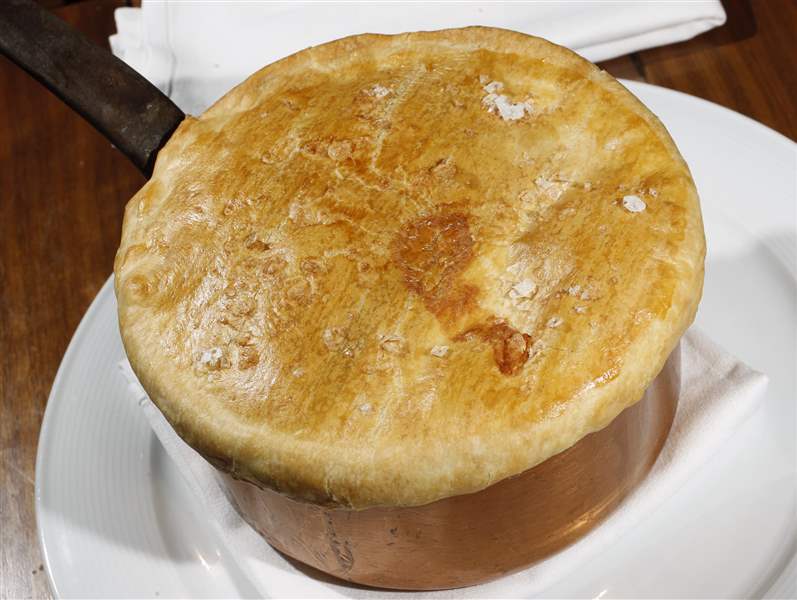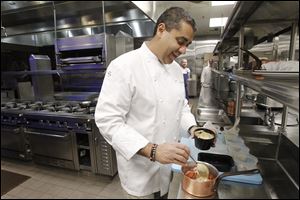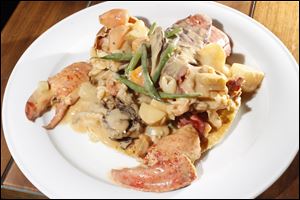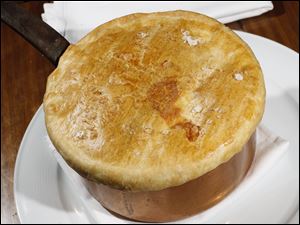
Michael Mina means flavor
Celebrity chef has made a name for himself when it comes to bold and balanced
4/10/2012
The Blade/Andy Morrison
Buy This Image

Celebrity chef Michael Mina prepares his signature dish lobster pot pie at his restaurant Saltwater at the MGM Grand Detroit.
DETROIT -- Three words: Lobster pot pie.
You don't even have to taste it to know how good that is. But I tasted it. And it was good. It was very, very good.
Celebrity chef Michael Mina created his recipe for lobster pot pie about 14 years ago, and it has gone on to become perhaps his signature dish. It is on the menu at nearly all of his 19 restaurants around the country. He has two restaurants at the MGM Grand Detroit -- Saltwater and Bourbon Steak -- and was in town recently to work on the menus with their chefs. He also found time to give cooking tips to local firefighters, explaining how to cook a little more healthfully and also how to put more flavor into less expensive cuts of meat.
Mr. Mina is all about flavor, saying particularly that he likes to produce food with flavors that are bold and balanced.
Which brings us back to the lobster pot pie. It is simple to make, he said -- though the instructions are so extensive we don't have nearly enough room to run them here -- and uses ordinary, readily available ingredients. It is a delectably rich concoction of lobster, aromatic vegetables, a hint of brandy, and a lot of cream, topped with a crust of pie dough. The server brings it to the table in the copper pot it is cooked in, removes the pie crust to a plate, and ladles the rest of the ingredients on top of it.
"It's a very hearty dish, and it's fun, because it's a nice show for the guests. You sell one, everyone sees it in the dining room, and all of a sudden you sell seven more," he said.

Lobster pot pie.
This attention to service recently has paid off in a big way, with a nomination for a James Beard Award for best service at his flagship restaurant, Michael Mina, in San Francisco. The winners of the awards will be announced next month.
"Any award or nomination is a symbol of what you do. You don't go in targeting it and say, 'I have to get this award,' you go in saying you want to provide great service and great hospitality for your guests," he said.
With so many restaurants owned by his company (his business partner is former tennis great Andre Agassi), he now has a staff that works on maintaining a high level of service at all their properties. They all stress that everyone at each restaurant should be thoroughly trained and should know where he fits into the interlocking puzzle of producing and serving food.
"I think confidence is the key to great service, and confidence only comes from knowing what you're doing," he said.
"Whether it is the back of the house [the kitchen] or the front of the house [the service], you create your own culture. And when you have a culture, you can have standards."
At 43, Mr. Mina is a husband and father of two boys. Born in Cairo and raised in Washington State, he was a teenager when he realized he wanted to be a chef. He went to the Culinary Institute of America in Hyde Park, N.Y., and moved to California to begin his culinary career. He was just 22 when he ran his first restaurant in San Francisco, Aqua. Since then, his empire of high-end eateries has expanded from Miami to Seattle.

"I feel very good about having 1,400 employees to give jobs to. You feed a multitude of people, you do enormous things for charities," he said. Although his business has grown, he still spends most nights working in the kitchen of his home base, Michael Mina. And he still experiments with new ways to bring out bold flavors in food.
Mr. Mina said he is always looking for a balance between acidity, sweetness, spice, and fat. Every dish does not necessarily have to include all four elements, he said, but he insists on a balance of whichever ones it has. A squeeze of lemon juice on top of a dish will taste too acidic, he explained, unless it is balanced with an appropriate amount of fat.
And fat plays a role in one of his biggest innovations, the butter bath. As owner of several steak houses, he knows he has to start with high-quality, well-marbled beef. All the best steak houses do that, but the difference with his is what they do with it before cooking. He puts the meat in a bath of hot, melted butter with herbs for 35-60 minutes, depending on the cut. You don't taste the butter, he said, but this technique thoroughly and safely warms up the meat all the way through before he briefly finishes it off on a grill.
"What you're doing is the reverse of taking a cold piece of meat and throwing it on a 600° grill. That toughens it up," he said.
He uses the same technique with the other meats he grills too: he gently preheats pork in bacon fat, chicken in chicken fat, and lamb in olive oil.
We tried cooking a steak in butter -- technically, we were poaching it -- before searing it in a pan on the stove, and the result was meat that was buttery soft. It was also just plain buttery; despite Mr. Mina's assurance that you don't taste the butter, you do. And it is divine. But the next time we make it, we might try blotting off the butter after we remove the steak from the bath and before we put it on the pan, just for the sake of reducing the calories.
The extraordinary texture and flavor come as a result of a bit of molecular gastronomy magic. When you are making it at home, keep the butter at a constant temperature of between 135-140°. You can submerge the meat in it for as long as you want and it is impossible to overcook; you are guaranteed to have a steak that is perfectly medium rare.
His recipe for roast chicken makes use of a related technique: The chicken is first cooked at a relatively low temperature, and then finished at a higher temperature to tighten the skin and make it crispy. Before roasting, he coats it with an easy sauce made of equal parts of soy sauce, honey, and (of course) melted butter, which lacquers the skin and turns it gorgeous shades of mahogany.
It was about the time we made his recipe for cheese fondue that we realized that restaurant cooking is never good for your diet. But it may be good for your soul, especially this hearty and remarkably delicious appetizer or party food. And it is easy to make, though it tastes like you spent hours.
His insanely addictive chocolate chip cookies are equally fattening, though perhaps equally worth it. They take a little bit of work, because you have to chop the chocolate and the toasted nuts, but they might well become your favorite chocolate chip cookie.
His milk chocolate panna cotta? More of the same. It's ridiculously fattening and ridiculously delicious, somewhat better than the richest chocolate pudding you can imagine. It is as impressive to serve as it is easy to make. And the flavors?
You guessed it. They're bold and balanced.
Contact Daniel Neman at dneman@theblade.com or 419-724-6155.
Butter-Poached Beef Rib-Eye
3 pounds (12 sticks) butter
3 cloves garlic, crushed
1/2 bunch thyme
2 bay leaves, preferably fresh
4 (6-ounce) boneless rib-eye steaks
Kosher salt and freshly ground black pepper, to taste
Salt flakes, such as Maldon, to taste
Place the butter in a saucepan and melt slowly while stirring over low heat. Remove from heat and let stand for at least 5 minutes. Skim the foam from the top and discard. Spoon clear butter into a glass container, stopping when you get to the milky solids at bottom. (Clarified butter will keep for about 1 month in the refrigerator).
Bring a large pot of water to a simmer over medium-low heat. Combine 1 1/2 quarts of the clarified butter, garlic, thyme, and bay leaves in a metal bowl or smaller pot and set it over the simmering water, without letting the bottom touch.
Gently heat the butter to 135 degrees, checking the temperature with a frying thermometer. Make sure the butter hovers somewhere between 135 and 140 degrees; this will ensure that the meat is cooked a perfect medium-rare.
Season the beef heavily with kosher salt and pepper and completely submerge it into the warm butter (the temperature of the fat will drop slightly.) Using tongs, rotate the meat occasionally for even cooking. The beef will need to poach for a minimum of 25-30 minutes and can go as long as 1 hour or more. As long as the temperature of the butter stays below 140 degrees the meat will not overcook. (Keep a close eye on the thermometer to maintain a constant temperature.)
When you are ready to serve, remove the beef with tongs, allowing the excess butter to drip off. Blot with paper towels. Season the beef well with kosher salt and pepper. Heat a large saute pan over medium-high heat and when hot, coat with 2 tablespoons of the clarified butter. Pan-sear the beef on all sides until well browned -- at this point, the meat is already cooked through from the poaching; you just want a slight crust on the outside for texture.
Remove the beef to a cutting board and let rest for at least 10 minutes before slicing in order to allow the juices to redistribute. Slice each steak against the grain into about 5 slices. Season lightly with Maldon sea salt.
Yield: 4 servings
Source: Michael Mina, via thedailymeal.com
Milk Chocolate Panna Cotta
1/2 pound milk chocolate
1/2 cup whole milk
1/2 teaspoon gelatin powder
1/2 teaspoon salt
1 1/2 cups cold heavy cream
Fleur de sel, for garnish (optional)
Gently melt the milk chocolate in a large bowl set over a saucepan of simmering water. Pour the milk into a pot and sprinkle the gelatin over the cold milk. Heat over low heat for 5 minutes, stirring occasionally. Add the salt and pour the mixture over the melted chocolate in the bowl and mix until smooth. Add the cold cream and mix until completely incorporated.
Fill four 6-ounce glasses ⅔ full with the mixture. Refrigerate until set, about 4 hours. Just before serving, garnish with fleur de sel, if using.
Yield: 4 servings
Source: Michael Mina, via ladlesandjellyspoons.com
Roast Chicken
1 good-quality whole chicken, about 3 1/2 pounds
1/4 cup ( 1/2 stick) unsalted butter
1/4 cup soy sauce
1/4 cup honey
Coarse salt
Black pepper
Fresh herbs, such as thyme and rosemary, optional.
Rinse the chicken inside and out with cold water, drain excess from cavity, and pat dry inside and out with paper towels. The chicken should be bone dry. Any excess moisture creates steam in the oven and prevents the skin from crisping.
Preheat oven to 350°.
Melt butter in a small pan, remove from heat, and thoroughly mix in soy sauce and honey. Allow to cool a bit, then rub the butter mixture all over the chicken, making sure to rub it in the crevices around the legs and wings. Drip off excess. Sprinkle with coarse salt and black pepper. Optional: Stuff a few sprigs of fresh herbs in the cavity of the bird.
Place chicken on a rack (if you have one) in a shallow roasting pan. There shouldn't be any excess liquid pooling in the bottom of the pan.
Place chicken in preheated oven for 1 hour and 15 minutes. Turn on stove vent and crank heat to 425°. Roast for another 10 minutes (the sear comes at the end of the cooking process because at that point the fat has been rendered out and the skin is tighter, so you get a crispier end product). The parts that look burned are just from the soy sauce and the caramelized sugars in the honey.
Remove chicken and test for doneness with instant-read thermometer. Insert probe in thickest part of the thigh for a reading of about 158°. Let chicken rest at least 10 minutes before carving.
Yield: 4 servings
Source: Adapted from Michael Mina, via Esquire
Michael Mina's Chocolate Chip Cookies
1 cup (2 sticks) unsalted butter, room temperature
3/4 cup sugar
3/4 cup dark brown sugar, lightly packed
2 large eggs
1 1/2 teaspoons vanilla extract
2 cups all-purpose flour
1 teaspoon baking soda
1 teaspoon salt
1 pound bittersweet chocolate, finely chopped
1/2 pound toasted pecans OR walnuts, finely chopped
Preheat oven to 350°.
Cut butter into chunks and put into the bowl of a mixer. Add sugar and brown sugar and mix at medium speed until thoroughly incorporated and the mixture is light. Add one egg, mix until incorporated, and then do the same with the other egg. Add vanilla extract and briefly mix.
Sift together flour, baking soda, and salt, and add to the butter-sugar mixture. Mix (starting slowly so the flour doesn't fly out of the bowl) just until it is all mixed together and you don't see any white spots of flour. Scrape down sides of bowl with a rubber spatula, if needed. With a wooden spoon, stir in chocolate and nuts.
Cut sheets of parchment paper to fit two cookie sheets. Roll dough into 1 1/2-inch balls and place on prepared cookie sheets 2 inches apart. Bake for 15 minutes. Allow to cool 1 minute on the cookie sheets; then remove the cookies to a rack to cool completely. Store in an airtight container
Yield: 40 cookies
Source: Adapted from Michael Mina, via chezpei.com